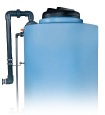You need to know how much chemical is in your storage tank so you can order more product at the right time to continue business without missing a beat. Not only that, but certain chemicals have to be stored at specific levels to maintain their properties. Replacing the chemical too early or too late can stall your operations, ruin your inventory, and impact your profits.
If you aren’t increasing your chemical storage capacity, it might be time to reevaluate your storage strategy. Over the last couple of years, many Poly Processing customers have shifted their approach to storing chemicals. They are increasing their total volume capacity in response to many of the market’s trends. External factors, such as the war in Ukraine and supply chain issues, have a trickle-down effect that impacts companies that need to buy and store chemicals. These companies are discovering that it makes good business sense to upsize their chemical storage capacity — both from an operational perspective and a financial one. Should your facility increase your chemical storage capacity? Here are some compelling reasons it might make sense for you to upsize.
Topics:
Chemical Storage
When you design a chemical storage tank, it’s commonplace to request extra or "spare" fittings in the sidewall. These fittings aren’t designated for anything specific, but at some point you might need to add another accessory to the tank. It’s convenient to have that fitting already installed and ready to go. This is a common practice, but it’s a potentially hazardous one. Every time you penetrate the sidewall of a tank, you introduce another potential leak. Fittings have gaskets that need to be maintained and monitored for cracking. Over time, fittings and gaskets can degrade and require replacement. The fittings also need to have the proper torque on them for a proper seal.
Topics:
Fittings and Accessories
Poly Processing Company invites you to visit us at booth #2015 at WEFTEC 2022, October 10-12 in New Orleans, LA.
Topics:
News and Customer Stories
As you’re researching and designing a chemical storage solution for your facility, the one thing you need more than anything else is information. The right information, plenty of it, and right where you can easily get it. Poly Processing realizes how critical it is for customers like you to have quick and easy access to the information you need. That’s why we’ve invested so much of our own resources into building and curating the industry’s best chemical storage knowledge library.
Poly Processing Company has updated our product line card and made it available on our website. Newly formatted with the latest information and our most popular core offerings, the product line card gives you an at-a-glance overview of the industry’s most innovative chemical storage products.
As industries develop innovative solutions to problems, many companies need polyethylene products that aren’t currently being produced by manufacturers. These organizations turn to specialists to design custom-built solutions.
Topics:
Applications
It’s common for wastewater treatment plants to rely on cross-linked polyethylene chemical tanks, but many municipal water treatment plants are using inferior linear polyethylene or fiberglass tanks. While the short-term benefits are tempting, using linear polyethylene or fiberglass tanks can be like pouring money down the drain. Instead, Poly Processing’s cross-linked polyethylene (XLPE) tanks give you better performance, greater cost-effectiveness, longer useful life, and more innovative solutions.
Topics:
Tank Design and Materials
For over 50 years, Poly Processing has been known as the trusted leader in the chemical storage industry. We’ve earned a reputation for technological innovation, which is built on a robust knowledge of chemical storage engineering and manufacturing. Our new website is dedicated to sharing that expertise with our customers. Because the more you know about the chemicals you’re storing — and the tank systems you’re using — the better equipped you’ll be to protect your inventory, your workers, and your bottom line.
Topics:
Tank Design and Materials,
Chemical Storage
In some chemical storage tank applications, it is necessary to install a ladder to allow for inspection, to check gauges, and to service level sensors or mixers. In this blog we will discuss the various ladder options available, as well as which ladder system is best for your storage application.
Topics:
Fittings and Accessories



